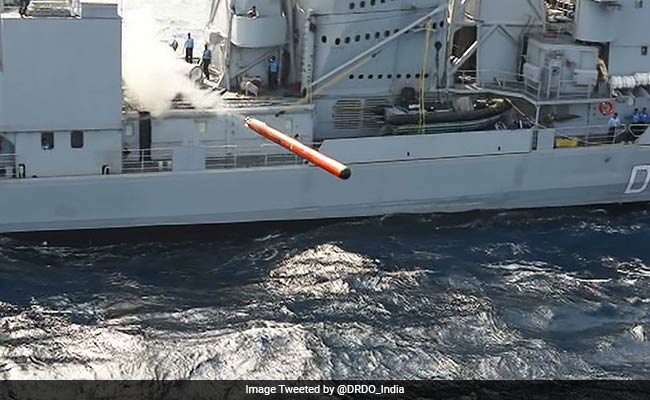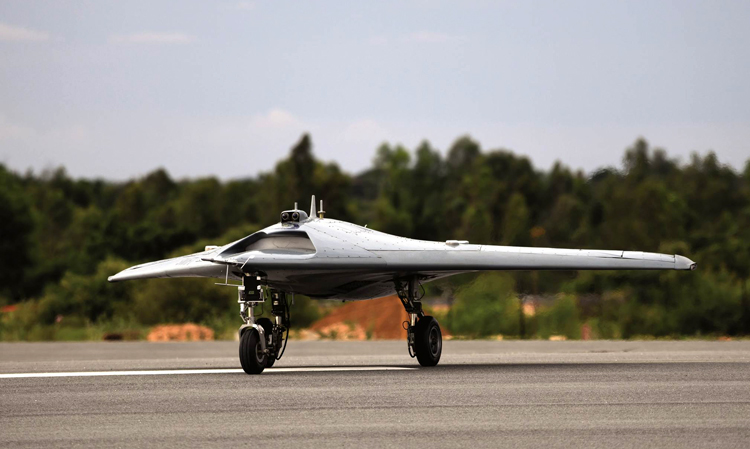AFI
SOURCE: AFI


India is currently in the process of evaluating options for the procurement of 110 multi-role fighter aircraft (MRFA) as part of its efforts to modernize and strengthen the Indian Air Force (IAF). The MRFA tender, estimated to cost around $25 billion, aims to replace aging fleet elements, bolster combat capabilities, and ensure air superiority for the next several decades. While the acquisition of advanced fighter jets remains an important component of India’s military modernization, a $25 billion investment could be allocated more strategically in several other ways to not only enhance India’s aerospace sector but also to bolster overall national defense and security.
Let’s explore how India can maximize this substantial budget in various sectors that will have both immediate and long-term impacts on the nation’s aerospace sector and the IAF’s combat strength.
Continue readingSOURCE: AFI


A striking illustration from Taiwan, depicting Lord Rama aiming an arrow at a Chinese dragon, has once again captured public attention after being discovered near the Chinese border. Initially published by a Taiwanese news portal in 2020, the cartoon went viral following the violent clashes between Indian and Chinese troops in the Galwan Valley, Ladakh, along the Line of Actual Control. The artwork, captioned with the bold assertion “We Conquer, We Kill,” symbolizes a narrative of resistance and defiance.
On June 15, 2020, a skirmish led to the death of 20 Indian soldiers. While China did not officially disclose its casualty figures, U.S. intelligence estimated that 35 Chinese soldiers perished in the confrontation. This clash was one of the deadliest in decades along the India-China border.
Continue readingSOURCE: AFI


The Defence Research and Development Organisation (DRDO) of India is on the cusp of a significant advancement in unmanned aerial warfare, with plans to soon conduct trials for the third iteration of the Unmanned Launched Precision Guided Missile (ULPGM V3). This latest variant promises enhanced capabilities over its predecessors, marking another step in India’s journey towards self-reliance in defence technology.
The ULPGM V3 represents a substantial upgrade from the earlier models, boasting improvements in range, precision, and adaptability. The development of the ULPGM V3 has seen collaboration between DRDO and Adani Defence, with the latter taking on the manufacturing responsibilities. This partnership aligns with India’s push for private sector involvement in defence production under the “Make in India” initiative.
Continue readingSOURCE: AFI


In a bold move that signals the future of air combat, Russia is making significant strides in the development of its sixth-generation fighter aircraft, with the Sukhoi Design Bureau at the forefront of this ambitious project. The head of Sukhoi’s Design Bureau recently shared key details about the next-generation fighter, emphasizing the aircraft’s need for a cutting-edge power plant that features significantly improved characteristics. This includes very low specific fuel consumption and high thrust, which are essential for meeting the demands of future aerial warfare.
The development of sixth-generation fighter jets is poised to revolutionize air combat, representing the next leap in military aviation after the fifth-generation fighters like the F-35 and Su-57. These future fighters will need to integrate advanced technologies and capabilities that surpass current aircraft, including stealth, autonomous systems, hypersonic speeds, advanced artificial intelligence (AI), and a networked approach to combat.
Continue readingSOURCE: AFI


In a significant stride towards enhancing India’s naval capabilities, the Defence Research and Development Organisation (DRDO) has developed the Electronic Heavy Weight Torpedo (EHWT), a cutting-edge weapon system designed to bolster the Indian Navy’s underwater combat prowess. This development marks a pivotal moment in India’s defense autonomy, aligning with the national vision of ‘Aatmanirbhar Bharat’ or self-reliant India.
The EHWT is an advanced, submarine-launched anti-submarine warfare (ASW) torpedo. It is an evolution of the previously inducted Varunastra torpedo, tailored specifically for submarine deployment. This torpedo is designed to engage quiet submarines effectively in both shallow and deep waters, showcasing a blend of high precision and significant range capabilities.
Continue readingSOURCE: AFI

Amidst global trends towards sixth-generation combat aircraft, the Aeronautical Development Agency (ADA) team behind the Tejas MkII program has robustly defended the continued development of this 4.5+ generation platform. Critics questioning the relevance of the Tejas MkII in an era eyeing future technologies have met with a well-structured argument from the ADA, emphasizing strategic foresight and technological continuity.
The Tejas MkII, or LCA Mk2, is not merely another fighter jet but a crucial stepping stone in the evolution of India’s indigenous aircraft design. It builds upon the lessons and technologies developed during the LCA Mk1 program, offering a platform to refine and innovate before leaping into more advanced systems.
Continue readingSOURCE: AFI


In a strategic move to safeguard its burgeoning space assets, Pakistan has reportedly initiated discussions with China to acquire Anti-Satellite (ASAT) missiles. This development comes in the wake of India’s successful ASAT test, known as Mission Shakti, which demonstrated India’s capability to neutralize satellites in low Earth orbit, thereby posing a potential threat to Pakistan’s space infrastructure.
Pakistan’s space program, while not as extensive as India’s or China’s, has been making steady progress, focusing on both civilian and military applications. Satellites are becoming central to Pakistan’s strategic operations, including communication, reconnaissance, and navigation. The country currently operates several satellites, with the most notable being the PakSat-1R for telecommunications and the PRSS-1 (Pakistan Remote Sensing Satellite) for earth observation, which are crucial for both civilian and defense sectors.
Continue readingSOURCE: AFI


India’s decision to withdraw from the Fifth Generation Fighter Aircraft (FGFA) program with Russia has often been attributed to concerns over the aircraft’s technical shortcomings, including its limited stealth capabilities. However, the financial burden of the project appears to have been the decisive factor in India’s pullout.
The FGFA program, based on Russia’s PAK-FA or Sukhoi T-50 platform, was initially envisioned as a joint venture with a 50:50 design and work-share agreement. This collaboration promised India a stake in the development of a cutting-edge stealth fighter. However, as the program progressed, India’s participation became increasingly limited, with Russia retaining much of the design and development work.
Continue readingSOURCE: AFI


The Ministry of Defence (MoD) in India has embarked on three ambitious projects aimed at enhancing the operational capabilities of its armed forces through the integration of surveillance radars and sensors. These initiatives are designed to provide real-time, actionable intelligence for both offensive and defensive military operations across the Indian Air Force (IAF), Army, and Navy.
For the IAF, the focus is on creating a comprehensive ‘composite picture’ of the airspace through the integration of all national air surveillance radars. This integration will occur within the framework of the Integrated Air Command and Control System (IACCS). The IACCS is not just a collection of hardware but an advanced software platform that automates the command and control processes essential for air operations.
Continue readingSOURCE: AFI


From December 19 to 22, 2024, Hanoi hosted the Vietnam International Defence Expo, where Indian defense enterprises made a significant impact. Bharat Electronics Limited (BEL), Hindustan Aeronautics Limited (HAL), Bharat Dynamics Limited (BDL), Mazagon Dock Shipbuilders Limited (MDL), Defence Research and Development Organisation (DRDO), Larsen & Toubro (L&T), Neo Power, BrahMos Aerospace, and Runflat Tyre Systems were among the key participants, drawing considerable attention and fostering discussions on future Indo-Vietnamese defense collaborations.
Continue readingSOURCE: AFI


The Defence Research and Development Organisation (DRDO) is making significant strides in unmanned aerial technology with the development of a High Altitude Long Endurance (HALE) Unmanned Aerial Vehicle (UAV) specifically designed for Intelligence, Surveillance, Target Acquisition, and Reconnaissance (ISTAR) roles. This new UAV is poised to enhance India’s aerial surveillance capabilities with its advanced specifications.
The UAV is designed to be a 5-tonne platform, making it robust enough to carry substantial equipment for various mission profiles. It will have a payload capacity of 2 tonnes, allowing it to be equipped with a variety of sensors, cameras, and potentially offensive capabilities for ISTAR missions.
Continue readingSOURCE: AFI


The Gas Turbine Research Establishment (GTRE) under India’s Defence Research and Development Organisation (DRDO) is pushing forward with the development of the Kaveri Derivative Engine (KDE), also known as the Kaveri Dry non-afterburning engine. This engine version produces 46 kN of thrust (IRA SLS – International Reference Atmosphere Sea Level Static) but comes with a substantial weight of up to 1180 kg, which is on the heavier side for engines in its class, even without an afterburner.
The KDE’s weight is particularly notable because, even without the additional mass of an afterburner section, it matches or exceeds that of some engines equipped with afterburners. This discrepancy could limit its application in manned fighter jets where weight-to-thrust ratio is critical for performance.
Continue readingSOURCE: AFI


Shiva Texyarn Ltd, a well-established name in the textile industry, has clinched a significant contract from the Department of Military Affairs for the supply of 16,000 pairs of Nuclear, Biological, and Chemical (NBC) Suits, specifically the Permeable MK V model. This deal marks a notable achievement for the company, reflecting its prowess in producing high-quality protective gear that adheres to the rigorous standards of the Indian Armed Forces.
The Permeable MK V suits are engineered to meet the stringent standards required for modern defense operations. These suits are lightweight, durable, and capable of offering extended protection in extreme environments. Shiva Texyarn’s ability to meet these rigorous specifications highlights its manufacturing prowess and its commitment to supporting India’s defense preparedness.
Continue readingSOURCE: AFI


In a candid reflection on one of India’s largest defense procurement efforts, Air Marshal M. Matheswaran (retired), who was intricately involved in the tendering process for the 126 Medium Multi-Role Combat Aircraft (MMRCA) for the Indian Air Force (IAF), has expressed regret over the decision to not proceed with the contract. “MMRCA should have gone through. It was a blunder not going for it,” he stated in an interview with the EurAsian Times, highlighting the potential benefits that were lost.
The MMRCA project, initially conceived in August 2000 with a proposal to acquire 126 Mirage 2000 II aircraft, underwent significant changes. By 2004, the original proposal was discarded, and in 2007, a new initiative was launched to procure 126 aircraft under the MMRCA banner. This process, which lasted nearly 15 years, involved extensive evaluations and negotiations before being abruptly terminated in 2016, with the Indian government opting instead to purchase 36 Rafale jets directly from France as an emergency measure.
Continue readingSOURCE: AFI


India is on the brink of a significant advancement in unmanned combat aerial technology with its top-tier project, the Remotely Piloted Strike Aircraft (RPSA). As preparations for the crucial Cabinet Committee on Security (CCS) papers gather pace, the project stands at a pivotal juncture, awaiting the momentum that CCS approval could provide.
The journey towards making the RPSA a reality involves rigorous scrutiny at the highest levels of government. The CCS approval is not just a formality but a vital step that could unlock funding, resources, and strategic focus necessary for this high-stakes project. “The preparations for the CCS papers are underway,” an official source revealed. With the Indian Air Force (IAF) expressing strong confidence in the RPSA’s potential, there’s a palpable optimism that this could sway the CCS’s decision in favor of the project.
Continue reading